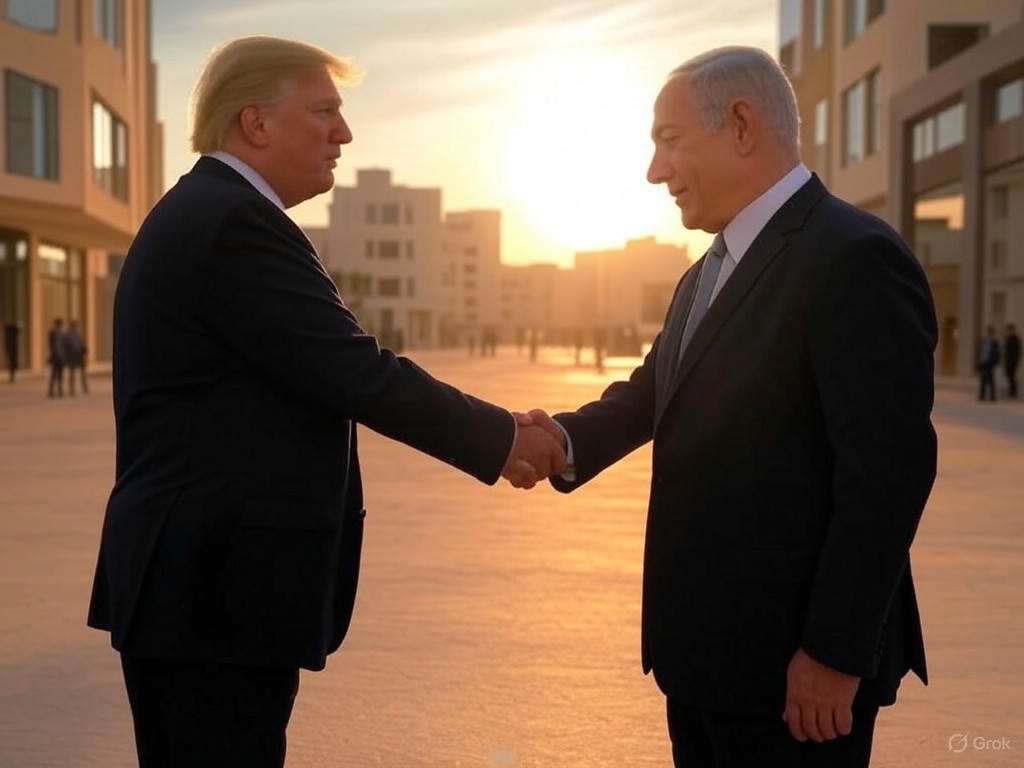
Hostage Deal Opportunity Israel’s Take on Trump’s Middle East Visit
Trump’s Gaza Plan: A Bold Step Toward Middle East Peace
As President Donald Trump hosts Israeli Prime Minister Benjamin Netanyahu at the White House, Trump’s Gaza plan takes center stage in what could be a pivotal moment for regional diplomacy. This meeting, held on February 4, 2025, highlights a transformative strategy aimed at reshaping the Gaza Strip amid ongoing conflicts. Trump’s Gaza plan proposes a U.S.-led overhaul, leveraging Israel’s strengthened position to foster broader peace initiatives across the Middle East.
At its core, Trump’s Gaza plan envisions not just reconstruction but a complete reset for the territory, potentially unlocking hostage deal opportunities and easing tensions. Yet, this approach has sparked debates about its feasibility and ethics, drawing mixed reactions from global leaders. Let’s explore how this plan intersects with Israel’s views and the wider diplomatic landscape.
Key Elements of the Trump Gaza Plan
Trump’s Gaza plan, unveiled during a high-profile press conference, outlines several ambitious components that could redefine the region’s future. One key aspect involves U.S. oversight of Gaza’s reconstruction, tackling the massive debris—estimated at over 50 million tonnes—to create new economic opportunities. This initiative promises unlimited jobs and housing, but it also includes controversial ideas like relocating Palestinians to safer areas.
Supporters argue that Trump’s Gaza plan could turn the territory into a thriving “Middle East Riviera,” drawing in investments from other Arab states. However, critics point out the potential for unintended consequences, such as strained international relations, making it a high-stakes gamble in Middle East peace efforts.
Challenges and Contradictions in Implementing Trump’s Gaza Plan
In the wake of the announcement, Trump’s Gaza plan has faced a flurry of clarifications and contradictions from his administration. For instance, on February 5, a White House spokesperson claimed any Palestinian displacement would be temporary, with no U.S. troops or funds involved. But just days later, Trump suggested buying Gaza and handing it to other nations, only to reverse course again.
These shifts raise questions: How can such a fluid strategy lead to lasting stability? It’s a reminder that even well-intentioned plans like Trump’s Gaza plan need clear guidelines to avoid confusion and build trust among stakeholders.
Israel’s Stance on Trump’s Gaza Plan
Prime Minister Netanyahu has expressed cautious support for Trump’s Gaza plan, aligning it with Israel’s security needs while distancing from elements like permanent Palestinian relocation. Analysts suggest that Israel’s potential reoccupation of Gaza might hinge more on Trump’s decisions than its own policies. This dynamic underscores how Trump’s Gaza plan could influence hostage deal opportunities and broader alliances.
Have you ever wondered how one leader’s vision could reshape an entire region’s future? In this case, Netanyahu’s backing could pave the way for peace with neighbors like Syria and Lebanon, but it also risks escalating tensions if not handled carefully.
Arab States’ Alternative to Trump’s Gaza Plan
In response to Trump’s Gaza plan, Arab leaders have rallied around Egypt’s $53 billion reconstruction proposal, emphasizing Palestinian-led efforts without displacement. This plan, adopted on March 4, 2025, includes modern infrastructure and a phased approach up to 2030, starkly contrasting Trump’s vision. While Hamas has endorsed it, both Israel and the U.S. remain wary due to security concerns.
This alternative highlights a key debate: Can Middle East peace be achieved through local ownership rather than external control? Trump’s Gaza plan might offer quick transformations, but the Arab strategy prioritizes sustainability and community involvement.
The Impact of Trump’s Gaza Plan on Regional Alliances
Trump’s Gaza plan also factors into efforts for Israel-Saudi normalization, a cornerstone of his Middle East strategy. Experts believe securing Saudi involvement could counterbalance criticisms of the plan and facilitate additional peace agreements. Yet, Saudi demands for progress on Palestinian issues make this a delicate balance.
Imagine a scenario where economic partnerships flourish alongside security pacts; that’s the potential upside of Trump’s Gaza plan if diplomatic hurdles are overcome.
Legal and Humanitarian Issues Surrounding Trump’s Gaza Plan
United Nations officials have voiced strong objections to Trump’s Gaza plan, labeling parts of it as potential ethnic cleansing and violations of international law. Legal scholars are working to clarify concepts like apartheid and Nakba in this context, emphasizing the need for human rights protections. These concerns add layers of complexity to what was intended as a peace-building effort.
If you’re following global affairs, you might ask: How do we ensure that ambitious plans like Trump’s Gaza plan respect humanitarian standards? Addressing these issues could be the key to its success or failure.
Practical Hurdles in Executing Trump’s Gaza Plan
Even beyond ethical debates, Trump’s Gaza plan faces logistical nightmares, such as clearing 50 million tonnes of debris, which could take up to 21 years according to BBC reports. Funding remains unclear, with no U.S. tax dollars confirmed, and security during reconstruction is a major unknown. International opposition from the UN and Arab states further complicates the timeline.
To put this in perspective, look at Ukraine’s reconstruction: Experts stress the importance of local involvement and planning, lessons that could apply to Gaza. What tips might help here? Start with transparent funding and community engagement to avoid pitfalls.
Lessons from Global Reconstruction and Trump’s Gaza Plan
Drawing from experiences like Ukraine’s rebuilding, successful projects emphasize local leadership and detailed frameworks—elements somewhat missing from Trump’s Gaza plan. A study from the Center for Economic and Policy Research highlights how early planning prevents delays and fosters ownership. This raises a question: Could adapting these strategies make Trump’s Gaza plan more effective?
For anyone interested in international development, here’s some actionable advice: When tackling post-conflict zones, prioritize inclusive dialogues to align visions and resources, potentially turning challenges into opportunities for peace.
Competing Visions for Gaza’s Future
As things stand, Trump’s Gaza plan and the Arab League’s proposal represent two paths forward, each with distinct pros and cons. The table below illustrates the differences:
| Trump’s Vision | Arab League’s Vision |
|---|---|
| U.S. control and Palestinian relocation | Palestinian administration with no displacement |
| Undefined reconstruction timeline | Phased plan by 2030 |
| Unclear funding | $53 billion budget |
These contrasts show how Trump’s Gaza plan might accelerate change but at what cost? The next few months will be crucial in deciding which approach gains traction.
Wrapping Up: The Road Ahead for Trump’s Gaza Plan
Trump’s Gaza plan holds the promise of multiple peace agreements, from Saudi Arabia to the Palestinians, but its controversies could hinder progress. As discussions continue, the focus remains on balancing bold ideas with practical realities for the people of Gaza. In the end, sustainable peace might require blending the best of both worlds.
What are your thoughts on this development? I’d love to hear your insights in the comments below, or share this article if it sparked your interest. For more on Middle East dynamics, check out our related posts on regional diplomacy.
References
- Goldberg, J. “Israel to Occupy Gaza? Trump’s Plan Explained.” Forward, Accessed February 2025.
- Pollack, K. “Trumpian Middle East Goal: 5 Arab-Israeli Peace Agreements.” The Washington Institute, February 2025.
- Chatham House. “Arab States Must Adapt Their Gaza Peace Plan.” Chatham House, March 2025.
- American Jewish Committee. “What Is Trump’s Proposal for Gaza?” AJC, February 2025.
- Wikipedia. “Donald Trump’s Gaza Strip Proposal.” Wikipedia, Accessed February 2025.
- Columbia Law Review. “Distinguishing Apartheid, Genocide, and Nakba.” Columbia Law Review, August 2024.
- CEPR. “Rebuilding Ukraine: Principles and Policies.” CEPR, 2024.
- Department of Homeland Security. “Middlebury College Report.” DHS, May 2022.
Trump’s Gaza plan, Israel occupation, Middle East peace, Arab-Israeli agreements, Gaza reconstruction, Trump-Netanyahu relations, Middle East diplomacy, Palestinian displacement, regional alliances, peace initiatives






